
Hasegawa 1/32 Seafire III (Conversion)
| KIT #: | 08052 |
| PRICE: | $44.00 MSRP |
| DECALS: | Two options |
| REVIEWER: | Tom Cleaver |
| NOTES: |
Greymatter
conversion sets: GMAA3212 - Seafire |

| HISTORY |
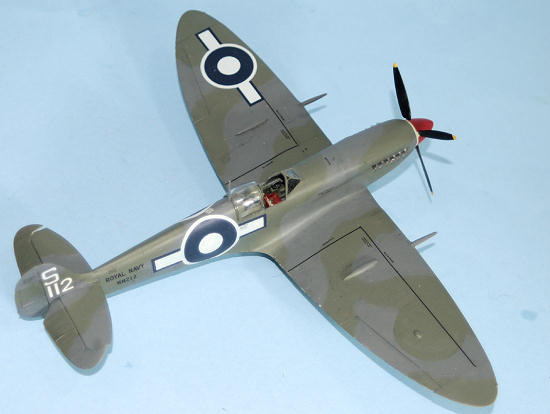 While
Supermarine had approached the Admiralty as early as 1938 with a proposal for a
naval version of the Spitfire, the operating philosophy of the Fleet Air Arm
resulted in the development of the Fairey Fulmar instead.
Only when the fighters operated by the Fleet Air Arm were shown to be
outperformed by their opposition was the Hurricane adapted for the role of fleet
air defense as the Sea Hurricane, and it was also shown to be outmoded.
The first Seafires, the Mk. I and Mk.II, were minimal conversions of
land-based Spitfires, with the primary addition being the addition of an A-frame
arrestor hook under the rear fuselage, and catapult spools.
Since the wings did not fold, these Spitfires could not be struck below
on a carrier, with the result that all maintenance at sea had to take place on
the open flight deck.
While
Supermarine had approached the Admiralty as early as 1938 with a proposal for a
naval version of the Spitfire, the operating philosophy of the Fleet Air Arm
resulted in the development of the Fairey Fulmar instead.
Only when the fighters operated by the Fleet Air Arm were shown to be
outperformed by their opposition was the Hurricane adapted for the role of fleet
air defense as the Sea Hurricane, and it was also shown to be outmoded.
The first Seafires, the Mk. I and Mk.II, were minimal conversions of
land-based Spitfires, with the primary addition being the addition of an A-frame
arrestor hook under the rear fuselage, and catapult spools.
Since the wings did not fold, these Spitfires could not be struck below
on a carrier, with the result that all maintenance at sea had to take place on
the open flight deck.
The first version of the
Seafire to specifically meet all the requirements for a carrier-based fighter
was the F. Mk.
The Seafire
The Seafire
HMS Indefatigable was
modified for Pacific service between October‑November 1944 and then joined the
Eastern Fleet in November 1944.
Indefatigable’s fighter units were the Seafires of 887 and 894 Squadrons, the
most-experienced Seafire units in the Royal Navy.
They were allocated the vital defensive duties of Combat Air Patrol (
The Seafires first entered
combat with the British
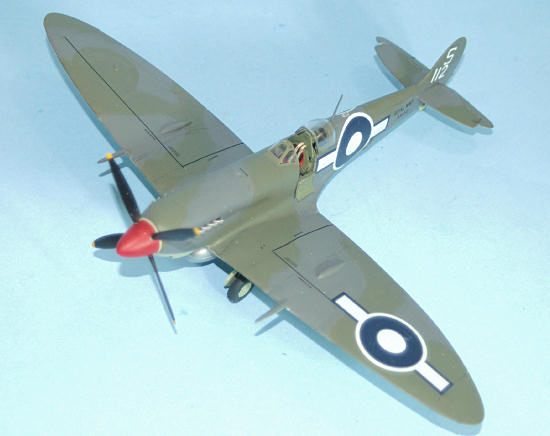 The British
Eastern Fleet entered the Pacific War in February 1945 as the British Pacific
Fleet, Task Force 57, to support the invasion of
The British
Eastern Fleet entered the Pacific War in February 1945 as the British Pacific
Fleet, Task Force 57, to support the invasion of
The top-scoring Seafire
pilot of the war was Sub‑Lieutenant R.H. Reynolds, DSC, of 894 Squadron, who
claimed 4.5 air victories in 1944–5. During the campaign in the Pacific, 887
Squadron claimed 12 victories, while 894 Squadron claimed 10 victories, with two
more victories claimed earlier in 1944 over
On August 15, 1945, three
Seafires of 887 and four Seafires of 894 Squadrons were assigned as escorts to
six Avengers of 820 Squadron and four Fireflies of 1772 Squadron, for a dawn
strike against the kamikazes on Kisarazu airfield, 30 miles south of Tokyo.
Operating with American aircraft from two other carriers, this was
officially the last airstrike of the Second World War, and was flown to prevent
any attempt by die-hard Japanese fliers to attack the Allied fleet off Tokyo Bay
after the surrender went into effect at noon
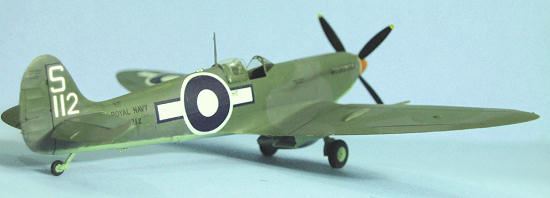 When the
formation was over Odaki Bay at 0545, they were hit by ten A6M5 Zeros and four
J2M Raidens of the 302nd Kokutai. In the ensuing dogfight, the
Seafires claimed 7 shot down, 3 probables and 4 damaged. While this was a
confused action with some US Navy Hellcats flying nearby also joining in, it is
very possible that Sub‑Lieutenant Gerry Murphy, who destroyed two Zeros, had
actually fired the last shots of the final dogfight of the Second World War.
When the
formation was over Odaki Bay at 0545, they were hit by ten A6M5 Zeros and four
J2M Raidens of the 302nd Kokutai. In the ensuing dogfight, the
Seafires claimed 7 shot down, 3 probables and 4 damaged. While this was a
confused action with some US Navy Hellcats flying nearby also joining in, it is
very possible that Sub‑Lieutenant Gerry Murphy, who destroyed two Zeros, had
actually fired the last shots of the final dogfight of the Second World War.
Japanese Chief Petty Officer Yoshinari was credited with shooting down the Seafire flown by Sub‑Lieutenant Fred Hockley, who bailed out and was captured. Nine hours after the surrender was announced on radio by the Emperor, Hockley was shot on orders from a senior Japanese officer. The Japanese officers who obeyed this order were, by their own admission, well aware of the surrender. The officer who ordered the execution of Hockley was hanged as a war criminal in November, 1945.
| THE KIT |
 This
Seafire
This
Seafire
I decided to do a model of Seafire L.III, 112/S NN212 of 887 Squadron, flown by Sub‑Lieutenant Gerry Murphy from HMS Indefatigable, who shot down two Japanese Zeros on August 15, 1945, which were definitely the last two Fleet Air Arm victories and may have been the final victories of the Second World War. I sourced the markings for this using the kit sheet for the stencils, and then getting the BPF insignia from a Dutch Decals sheet, and the rest of the Royal Navy markings from various decal sheets in the decal dungeon.
| CONSTRUCTION |
This is an advanced
conversion project, but it is not as difficult as it looks at first.
The worst part of the
project was the replacement of the wings.
This seems daunting at first, but it’s easy.
I cut off the plastic wings, then attached the resin wings to the plastic
center section. I then taped the
fuselage together and used it to test-fit the wings to the fuselage.
I found I needed to thin down the area of the wing attachment on the
fuselage for a smooth fit. After
that, I attached the gun bulges in their proper positions, and attached the
wingtips. The wingtips seemed too
wide in chord to fit the wing, and further test-fitting of the wing to the fusel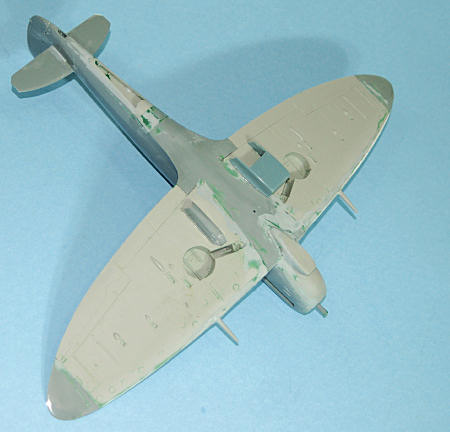 age
revealed the resin wing was overall too narrow in chord (Greymatter has since
corrected this). I corrected the
wings here by gluing Evergreen rod on the wing leading edge, then filling in
with Squadron Green Putty. When
that was dry I sanded it smooth and the wing fit the fuselage with no problem.
This was the only hard part of the entire conversion.
I finished off by attaching the radiator provided by Greymatter, and the
oil cooler I had cut off the donor kit.
age
revealed the resin wing was overall too narrow in chord (Greymatter has since
corrected this). I corrected the
wings here by gluing Evergreen rod on the wing leading edge, then filling in
with Squadron Green Putty. When
that was dry I sanded it smooth and the wing fit the fuselage with no problem.
This was the only hard part of the entire conversion.
I finished off by attaching the radiator provided by Greymatter, and the
oil cooler I had cut off the donor kit.
I then cut out the lower
fuselage area and test-fitted the attachment of the arrestor hook assembly.
I also cut and assembled the horizontal stabilizers and fitted the
elevators.
I assembled the fuselage,
using the Greymatter seat and Eduard photoetch RAF seatbelts in the cockpit. The
arrestor hook assembly fit well, and was puttied over and then sanded smooth
before I attached the arrestor hook in the raised position.
I then attached the wings to
the fuselage, and puttied the upper wing-fuselage joint.
The lower cowling with the Aero-Vee filter fit easily, though the reare
part of the Aero-Vee filter had to be puttied to fit to the lower center
section.
When everything was sanded
smooth, I rescribed the panel lines on the fuselage.
While in Australia in
May-June 1945, 887 Squadron obtained a supply of US 75-gallon metal tanks from
the RAAF, and jury-rigged a mount for their Seafires to carry these tanks, which
provided more gas than the standard “slipper” tanks and did not reduce
performance as the other tanks did.
I used a 75-gallon tank left over from a Trumpeter P-47 kit for this.
| COLORS & MARKINGS |
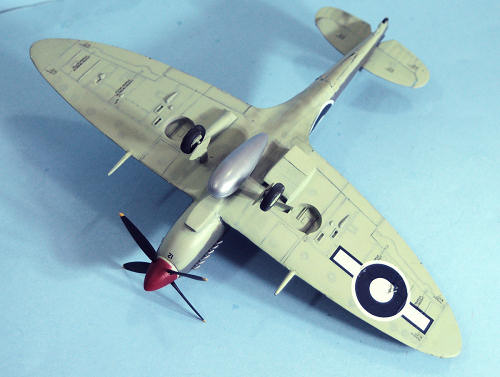
Painting:
The model was first
pre-shaded with black paint along the panel lines, then Xtracrylix RAF “Dark Sea
Grey,” “Dark Slate Grey” and “Sky” were applied freehand for the Fleet Air Arm
Temperate Sea Scheme.
Decals:
I found two photographs of
887 Squadron Seafire IIIs, which showed that the airplanes used oversized large
BPF insignia; this was likely done to insure that their erstwhile USN allies
recognized the unfamiliar shape of the Seafire as “friendly.”
I was able to source the BPF decals from the Dutch Decals sheet “Dutchies
in de FAA”, which were originally meant for the 1/32 Hellcat.
The “Royal Navy” and the serial NN212 came from leftover decals for the
Fisher Sea Fury, while “S/112" was sourced out of other Fleet Air Arm decal
sheets.
| FINAL CONSTRUCTION |
You don’t find airplanes in
a marine saltwater environment with a lot of “dings,” so I only gave a minor
“ding” to the area where the pilot stepped on the wing.
I applied exhaust and oil stains with Tamiya “Smoke.”
I attached the prop, wheels, and drop tank, then unmasked the canopy and
placed it in the open position with the side flap dropped.
| CONCLUSIONS |
The Seafire III is one of
the most interesting versions of the Spitfire.
With its oversized BPF insignia and the strange-looking US drop tank
below, this model makes an excellent addition to my collection of 1/32
Spitfires. The conversion is not
for the faint-hearted, but it is not that difficult if you take your time.
As I said above, the wing situation has been dealt with, but if you
should get an older wing, the fix is not hard.
Highly recommended to all “Boffins.”
Review kit courtesy of my
wallet. Conversion sets courtesy of
Greymatter Figures. Get yours at:
http://www.greymatterfigures.com/
If you would like your product reviewed fairly and quickly, please contact me or see other details in the Note to Contributors.